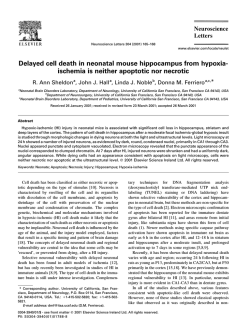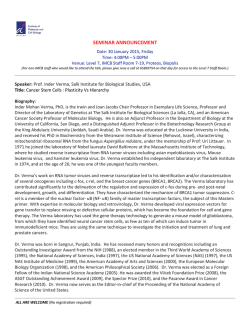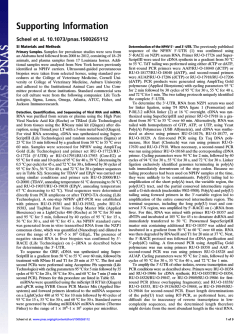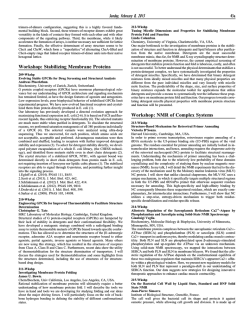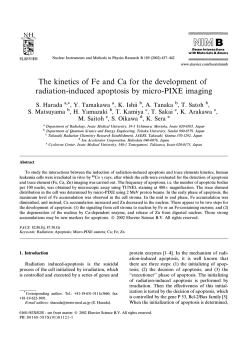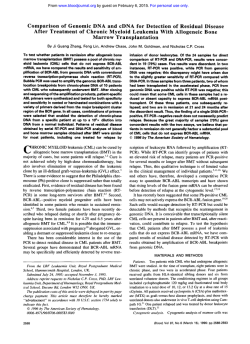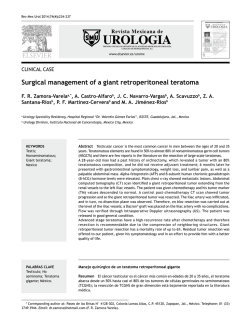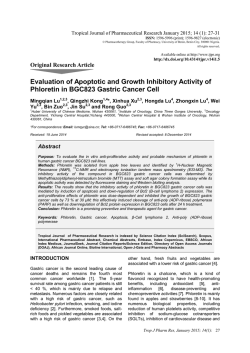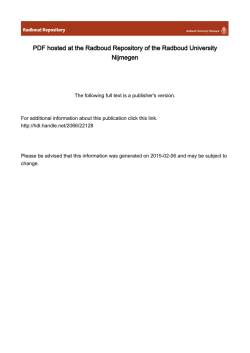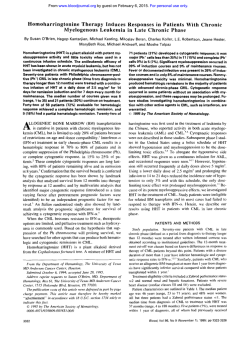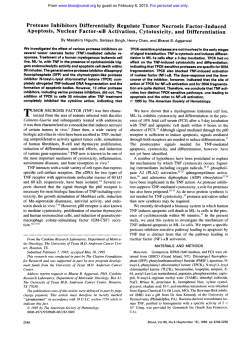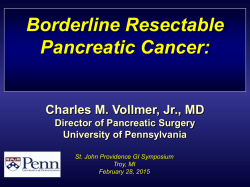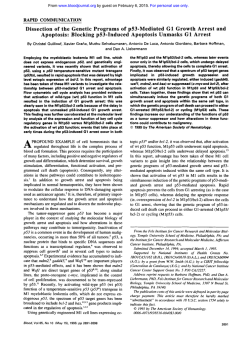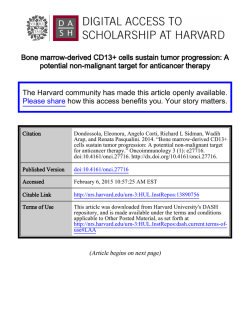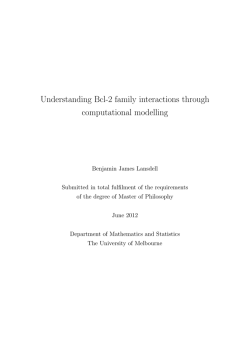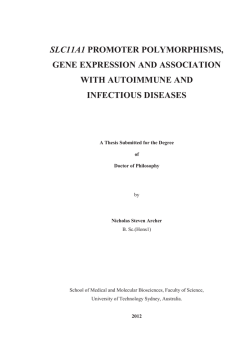
PDF (149 kB) - Cancer Letters
Cancer Letters 292 (2010) 149–152 Contents lists available at ScienceDirect Cancer Letters journal homepage: www.elsevier.com/locate/canlet Mini-review RNA polymerase – An important molecular target of triptolide in cancer cells Jingxuan Pan * Department of Pathophysiology, Zhongshan School of Medicine, Sun Yat-sen University, 74 Zhongshan Road II, Guangzhou 510089, People’s Republic of China a r t i c l e i n f o Article history: Received 5 November 2009 Received in revised form 26 November 2009 Accepted 27 November 2009 Keywords: Triptolide RNA polymerase Molecular target Cancer a b s t r a c t Triptolide, a diterpenoid triepoxide, is the key biological component of Tripterygium wilfordii Hook. f. which was used in traditional Chinese medicine for centuries to treat inflammation and autoimmune diseases. Triptolide has shown potent activity in not only antiinflammation and immune modulation, but also antiproliferative and proapoptotic activity in many different types of cancer cells. However, for a long time, the precise molecular target(s) of triptolide have remained elusive. Recently, several groups discovered that triptolide inhibited the activity of RNA polymerase. This review will focus on these breakthrough findings about the molecular target of triptolide and its implications for targeted-cancer therapeutics. Ó 2009 Elsevier Ireland Ltd. All rights reserved. 1. Introduction Traditional Chinese medicine has used Tripterygium wilfordii Hook. f. for centuries to treat inflammation and autoimmune diseases [1–4]. Among the many small molecules extracted and purified from this shrub-like vine, triptolide is the key biologically active component that mediates immunosuppression and anti-inflammation, and antineoplastic effect [3,5]. Triptolide has been shown antiproliferative and proapoptotic activity in a broad spectrum of cancer cells (Table 1). Although the precise molecular targets remain elusive, recent studies in cancer cells have revealed that RNA polymerase may be an important target of triptolide. This review will focus on the inhibitory effect of triptolide on the RNA polymerase and its implications for targeted-cancer therapeutics. 2. Triptolide inhibits growth of tumor cells at nanomolar concentrations Triptolide was first characterized as a diterpenoid triepoxide lactone containing an 18 (4f3) abeo-abietane skele* Tel./fax: +86 20 87332788. E-mail address: [email protected] 0304-3835/$ - see front matter Ó 2009 Elsevier Ireland Ltd. All rights reserved. doi:10.1016/j.canlet.2009.11.018 ton in 1972 [6]. Since then, a large body of literature has demonstrated that triptolide at low concentrations inhibits growth of different types of cancer cells including hematologic malignancy and solid tumor cells. The IC50 values were listed in Table 1. In addition, triptolide potentiates the activities of other chemotherapeutic agents and therefore may be useful not only as a monotherapy but also in combination with other cytotoxic drugs for cancer treatment. For instance, triptolide enhances the bortezomib-induced apoptosis in multiple myeloma cells by inactivating PI3 K/Akt/NF-jB pathways [17]. It also sensitizes tumor cells to apoptosis stimuli such as Apo2/TRAIL, tumor necrosis factor a, and various chemotherapeutic agents [10,17–19]. Of note, triptolide was effective against tumor cells that overexpress the MDR1 and are resistant to the effects of other chemotherapeutic compounds (e.g., paclitaxel) [20]. 3. Mechanism of triptolide to inhibit growth of tumor cells Since its discovery in 1972, triptolide with its unique chemical structure attracts numerous scientists to elucidate its pharmacological mechanisms. Early studies emphasized the inhibitory effect of triptolide on NF-jB activation since 150 J. Pan / Cancer Letters 292 (2010) 149–152 Table 1 IC50 values of triptolide in tumor cells. Tumor type Cell lines IC50 (nM) References Chronic myelogenous leukemia (CML) KBM5 6.1 [7] KBM5-T315I BaF3-Bcr-Abl BaF3-T315I K562 Primary blast cells (imatinibresistant) U937 5.5 6.5 5.4 5.7 4.8– 13.3 [7] [7] [7] [7] [7] 6.5 [8] Molt-4 HL-60 HEL Primary blast cells SMMC Jurkat 17 7.5 2.6 15.5– 47.8 32 27.5 [9] [10] [11] [12] [10] [10] Raji 25.08 [13] Namalwa RPMI8226 NCI-H929 U266 HCT-15 HCT-116 SW1116 Lovo HT29 Lsd174T SMMC-7721 BEL-7402 Miapaca2 BxPC3 SGC-7901 MKN-28 MDA-MB-231 MX1 MCF-7 SK-OV-3 HO-8910 PC-3 DU-145 786-O KB 10 69.4 4.8 72.2 29 10 52 77 2.8 3.5 18 20 5.2 20 15 200 24 3.2 19 10 28 43 24 22 43 [8] [14] [8] [14] [9] [9] [9] [8] [15] [8] [9] [9] [8] [8] [9] [9] [9] [8] [9] [9] [9] [9] [9] [9] [9] OEC-M1 SCC25 KB 3.56 3.75 4.13 [16] [16] [16] Rh30 HeLa U251 14 47 49 [9] [9] [9] Acute myeloid leukemia (AML) Acute lymphoid leukemia (ALL) Non-Hodgkin’s lymphoma Lymphoma Mutiple myeloma Colon cancer Liver cancer Pancreatic cancer Stomach cancer Breast cancer Ovarian cancer Prostate cancer Kidney cancer Oral squamous cell carcinoma Oral epidermoid carcinoma Tongue squamous cancer Gingival epidermoid carcinoma Rhabdomyosarcoma Cervix cancer Neurogliocytoma the latter is critical for both inflammation and tumorigenesis [14,21,22]. However, the spectrum of genes suppressed by triptolide is much larger and beyond the gene spectrum controlled by NF-jB [8]. Vispe et al. examined the effect of triptolide on gene expression with a whole human genomic DNA microarrays containing 45,015 probes, and discovered that a 4-h treatment with triptolide (0.45 lM) led to upregulation of 160 genes and downregulation of 1511 in nonsmall cell lung cancer cell line A549 [8]. Du et al. reported the underexpression of 117 genes in triptolide-treated leu- kemia Jurkat cells [23]. Independently, we reported that triptolide repressed the expression of Bcr-Abl, KIT, PDGFRa, and Jak2, respectively [7,11,24,25]. Apoptosis related proteins such as XIAP, Bcl-2, Mcl-1, and the cell cycle regulators CDC25A, Polo-like kinases Plk2, Plk3, and Plk4 were significantly suppressed by triptolide [19,20,26]. Heat shock protein 90 and Heat shock protein 70 were also decreased by triptolide [27]. Moreover, triptolide suppresses the transactivation of general transcription factors [e.g., AP-1 (activator prtein-1), NFAT and HSF1 (heat shock factor 1), TAFs, TBP, CEBPA-CEBPB, myc, fos, SP1, Jun B] and specific transcription factors (ZNFs, NRF1, NFYA, and HSF2) [8]. Therefore, it is impossible to explain the suppression of such a broad range of genes by triptolide treatment simply by inactivation of NF-jB pathway. McCallum et al. showed that triptolide inhibits de novo total RNA transcription in A549 and THP-1 tumor cells [28]. Leuenroth and Crews demonstrated that triptolideinduced nuclear speckle rounding indicating mRNA splicing had ceased, and normal nucleolar structure also disappeared [29]. The nuclear substructural changes are associated with a decrease in RNA polymerase II (RNA Pol II) COOH-terminal domain Ser2 phosphorylation. After RNA Pol II inhibition, RNA Pol I transcriptional activity is also attenuated, affecting RNA ribosome biogenesis. Therefore, Leuenroth and Crews remarked that triptolide suppresses global transcription in a concentration-dependent manner. Independently, we demonstrated that triptolide decreases the activity of RNA Pol II in different leukemia cells (e.g., KBM5, HMC-1, EOL-1 and HEL cells) [7,11,24,25]. Recently, Vispe et al. measured the effect of triptolide on the RNA synthesis by using [H3]uridine incorporation, and found that triptolide inhibits both total RNA and mRNA neosynthesis by up to 80% [8]. However, triptolide is not a DNA binder; an in vitro transcription assay did not support that triptolide have the ability to directly interact and inhibit the elongating RNA polymerase II complex. Despite so, it can not be ruled out a possibility that the reconstituted in vitro assay did not completely reflect the in vivo RNA polymerase II complex. Vispe et al. discovered that RPB1, the catalytic and the largest RNA polymerase II main subunit, was shown downregulated by 2-h treatment of triptolide; this effect was further amplified with longer incubation times up to 16 h [8]. The presence of proteasome inhibitors (i.e., bortezomib and epoxomycin) failed to prevent the triptolide-induced RPB1 downregulation, indicating that triptolide acts by stimulating RPB1 degradation [8]. Being consistent with this notion, depletion of RBP1 in A549 cells exhibits resistance to the cytotoxic activity of triptolide. Together, the available data suggest that triptolide mediates the general transcription inhibition with unique mechanisms distinct from previously characterized transcription inhibitors (e.g., actinomycin D and a-amanitin) [8]. 4. Implication: triptolide overcomes oncogene addiction Some tumors show a surprisingly tight dependence on the continued activity of a specific oncogene, even in the J. Pan / Cancer Letters 292 (2010) 149–152 presence of additional tumorigenic lesions [30,31]. This phenomenon is referred to as ‘‘oncogene addiction”. Typical examples include Bcr-Abl in the chronic phase of chronic myelogenous leukemia (CML), KIT in gastrointestinal stromal tumors (GISTs) and systemic mastocytosis, and platelet-derived growth factor receptor alpha (PDGFRa) in hypereosinophilic syndrome (HES) [32–34], Jak2 in myeloproliferative disorders (MPDs). Thus, targeted therapeutics that specifically inhibit the activity of particular oncoproteins have been developed [35]. Inactivation of tyrosine kinases (e.g., Bcr-Abl, KIT, PDGFRa and Jak2) by selective small-molecule inhibitors (e.g., imatinib) is effective for CML, GISTs, and HES [31,36]. Unfortunately, acquired resistance to imatinib develops and is an emerging clinical problem [37]. Lowering the expression of the oncoproteins Bcr-Abl, KIT and PDGFRa by transcription inhibitors (e.g., triptolide, actinomycin D, flavopiridol, roscovitine), Hsp90 inhibitors (e.g., 17-AAG, IPI-504, celastrol), or translation inhibitors (e.g., homoharringtonine) can effective kill these oncogene-addicted tumors cells. The loss of total KIT protein would result in reduced active autophosphorylated KIT, which leads to subsequent abrogation of downstream signal transduction. Despite the lack of specificity of inhibitors of transcription or translation, addressing oncogene addiction may provide the biological context for a therapeutic window to selectively kill malignant cells [32,38– 43]. Unlike the use of selective tyrosine kinase inhibitors, this oncogene-addiction therapeutic approach is not hampered by mutations in the coding sequences of the oncogenes. Because triptolide possesses a potent inhibitory effect of transcription with unique mechanisms, we and others attempted to investigate its translation efficacy using different oncogene addiction models. First, we discovered that triptolide potently downregulated Bcr-Abl at the level of transcription and inhibited the growth and induced apoptosis in CML cells harboring wild-type Bcr-Abl or Bcr-Abl-T315I mutation [7]. We confirmed this potent activity with two pairs of CML cell lines (KBM5 versus KBM5-T315I, BaF3–Bcr-Abl versus BaF3–Bcr-Abl-T315I) and primary cells from CML patients with clinical resistance to imatinib [7]. Additionally, triptolide inhibited the growth of imatinib-resistant Bcr-Abl-T315I as well as imatinib-sensitive CML cells in nude mouse xenografts; the protein level of Bcr-Abl in imatinib-sensitive (KBM5) or -resistant (KBM5-T315I) CML cells was decreased after triptolide treatment. The antineoplastic activity of triptolide in imatinib-resistant CML cells was confirmed by Mak et al. who also demonstrated that triptolide-induced cell death independent of cellular responses to imatinib in quiescent CD34+ primitive blast crisis CML progenitor cells [44]. Similarly, we demonstrated that triptolide effectively inhibits the growth of cells and induces apoptosis in cells bearing both juxtamembrane and activation loop mutants of KIT, including the imatinib-resistant D816 V KIT, involved in systemic mastocytosis [25]. In an alternative model, EOL-1 cells bearing FIP1L1-PDGFRa and BaF3 cells expressing wild-type or T674I FIP1L1-PDGFRa which showed resistance to imatinib were sensitive to 151 triptolide with downregulated FIP1L1-PDGFRa levels [24]. The discovery of oncogene addiction in myeloproliferative disorders (MPDs) driven by the gain-of-function mutant Jak2V617F has attracted intense interest in targeted therapy for MPDs [11]. We examined and found that triptolide potently downregulated the transcription of Jak2 by inhibiting the activity of RNA polymerase. Triptolide inhibited the in vitro and in vivo growth of tumor cells harboring Jak2V617F [11]. Earlier clinical trials in China revealed that triptolide achieved a total remission rate of 71% in mononucleocytic leukemia and 87% in granulocytic leukemia, which was more effective than any other chemotherapeutic agent currently available [20]. A phase I clinical trial of the effect of a water-soluble derivative of triptolide on solid tumors is ongoing in Europe [12]. Further development of triptolide derivatives may produce promising anticancer drug candidate. 5. Conflicts of interest None declared. Acknowledgements This study was supported by grants from the National High Technology Research and Development Program of China (863 Program Grant 2008AA02Z420 to J. Pan), the Major Research Plan of the National Natural Science Fund of China (Grant 90713036 to J. Pan), and the National Basic Research Program of China (973 Program Grant 2009CB825506 to J. Pan). The author thanks Dr. Sai-Ching J. Yeung (The University of Texas M.D. Anderson Cancer Center, Houston, TX, USA) for a critical reading of the manuscript. References [1] T.W. Corson, C.M. Crews, Molecular understanding and modern application of traditional medicines: triumphs and trials, Cell 130 (2007) 769–774. [2] X.L. Tao, Y. Sun, Y. Dong, Y.L. Xiao, D.W. Hu, Y.P. Shi, Q.L. Zhu, H. Dai, N.Z. Zhang, A prospective, controlled, double-blind, cross-over study of Tripterygium wilfodii Hook. f. in treatment of rheumatoid arthritis, Chin. Med. J. (Engl) 102 (1989) 327–332. [3] X. Jiang, Clinical observations on the use of the Chinese herb Tripterygium wilfordii Hook. for the treatment of nephrotic syndrome, Pediatr. Nephrol. 8 (1994) 343–344. [4] T. Efferth, P.C. Li, V.S. Konkimalla, B. Kaina, From traditional Chinese medicine to rational cancer therapy, Trends Mol. Med. 13 (2007) 353–361. [5] X. Tao, H. Schulze-Koops, L. Ma, J. Cai, Y. Mao, P.E. Lipsky, Effects of Tripterygium wilfordii hook F extracts on induction of cyclooxygenase 2 activity and prostaglandin E2 production, Arthritis Rheum. 41 (1998) 130–138. [6] S.M. Kupchan, W.A. Court, R.G. Dailey Jr., C.J. Gilmore, R.F. Bryan, Triptolide and tripdiolide, novel antileukemic diterpenoid triepoxides from Tripterygium wilfordii, J. Am. Chem. Soc. 94 (1972) 7194–7195. [7] X. Shi, Y. Jin, C. Cheng, H. Zhang, W. Zou, Q. Zheng, Z. Lu, Q. Chen, Y. Lai, J. Pan, Triptolide inhibits Bcr-Abl transcription and induces apoptosis in STI571-resistant chronic myelogenous leukemia cells harboring T315I mutation, Clin. Cancer Res. 15 (2009) 1686–1697. [8] S. Vispe, L. DeVries, L. Creancier, J. Besse, S. Breand, D.J. Hobson, J.Q. Svejstrup, J.P. Annereau, D. Cussac, C. Dumontet, N. Guilbaud, J.M. Barret, C. Bailly, Triptolide is an inhibitor of RNA polymerase I and II- 152 [9] [10] [11] [12] [13] [14] [15] [16] [17] [18] [19] [20] [21] [22] [23] [24] [25] [26] J. Pan / Cancer Letters 292 (2010) 149–152 dependent transcription leading predominantly to down-regulation of short-lived mRNA, Mol. Cancer Ther. 8 (2009) 2780–2790. Z. Li, Z.L. Zhou, Z.H. Miao, L.P. Lin, H.J. Feng, L.J. Tong, J. Ding, Y.C. Li, Design and synthesis of Novel C14-Hydroxyl substituted triptolide derivatives as potential selective antitumor agents, J. Med. Chem. (2009). E.W. Chan, S.C. Cheng, F.W. Sin, Y. Xie, Triptolide induced cytotoxic effects on human promyelocytic leukemia, T cell lymphoma and human hepatocellular carcinoma cell lines, Toxicol. Lett. 122 (2001) 81–87. Q. Chen, Z. Lu, Y. Jin, Y. Wu, and J. Pan, Triptolide inhibits Jak2 transcription and induces apoptosis in human myeloproliferative disorder cells bearing Jak2V617F through caspase-3-mediated cleavage of Mcl-1, Cancer Lett., in press, doi:10.1016/j.canlet. 2009.10.019. B.Z. Carter, D.H. Mak, W.D. Schober, T. McQueen, D. Harris, Z. Estrov, R.L. Evans, M. Andreeff, Triptolide induces caspase-dependent cell death mediated via the mitochondrial pathway in leukemic cells, Blood 108 (2006) 630–637. C. Zhang, G.H. Cui, F. Liu, Q.L. Wu, Y. Chen, Inhibitory effect of triptolide on lymph node metastasis in patients with non-Hodgkin lymphoma by regulating SDF-1/CXCR4 axis in vitro, Acta Pharmacol. Sin. 27 (2006) 1438–1446. L. Yinjun, J. Jie, W. Yungui, Triptolide inhibits transcription factor NFkappaB and induces apoptosis of multiple myeloma cells, Leuk. Res. 29 (2005) 99–105. Y. Aoyagi, Y. Hitotsuyanagi, T. Hasuda, S. Matsuyama, H. Fukaya, K. Takeya, R. Aiyama, T. Matsuzaki, S. Hashimoto, Fluorination of triptolide and its analogues and their cytotoxicity, Bioorg. Med. Chem. Lett. 18 (2008) 2459–2463. Y.W. Chen, G.J. Lin, W.T. Chia, C.K. Lin, Y.P. Chuang, H.K. Sytwu, Triptolide exerts anti-tumor effect on oral cancer and KB cells in vitro and in vivo, Oral. Oncol. 45 (2009) 562–568. K.Y. Lee, W. Chang, D. Qiu, P.N. Kao, G.D. Rosen, PG490 (triptolide) cooperates with tumor necrosis factor-alpha to induce apoptosis in tumor cells, J. Biol. Chem. 274 (1999) 13451–13455. S. Frese, F. Pirnia, D. Miescher, S. Krajewski, M.M. Borner, J.C. Reed, R.A. Schmid, PG490-mediated sensitization of lung cancer cells to Apo2L/TRAIL-induced apoptosis requires activation of ERK2, Oncogene 22 (2003) 5427–5435. T.M. Kiviharju, P.S. Lecane, R.G. Sellers, D.M. Peehl, Antiproliferative and proapoptotic activities of triptolide (PG490), a natural product entering clinical trials, on primary cultures of human prostatic epithelial cells, Clin. Cancer Res. 8 (2002) 2666–2674. S. Yang, J. Chen, Z. Guo, X.M. Xu, L. Wang, X.F. Pei, J. Yang, C.B. Underhill, L. Zhang, Triptolide inhibits the growth and metastasis of solid tumors, Mol. Cancer Ther. 2 (2003) 65–72. M. Karin, F.R. Greten, NF-kappaB: linking inflammation and immunity to cancer development and progression, Nat. Rev. Immunol. 5 (2005) 749–759. D. Qiu, P.N. Kao, Immunosuppressive and anti-inflammatory mechanisms of triptolide, the principal active diterpenoid from the Chinese medicinal herb Tripterygium wilfordii Hook. f, Drugs 4 (2003) 1–18. Z.Y. Du, X.Y. Li, Y.C. Li, S.Y. Wang, Analysis of triptolide-regulated gene expression in Jurkat cells by complementary DNA microarray, Acta Pharmacol. Sin. 24 (2003) 864–872. Y. Jin, Q. Chen, Z. Lu, B. Chen, J. Pan, Triptolide abrogates oncogene FIP1L1-PDGFRalpha addiction and induces apoptosis in hypereosinophilic syndrome, Cancer Sci. 100 (2009) 2210–2217. Y. Jin, Q. Chen, X. Shi, Z. Lu, C. Cheng, Y. Lai, Q. Zheng, J. Pan, Activity of triptolide against human mast cells harboring the kinase domain mutant KIT, Cancer Sci. 100 (2009) 1335–1343. C.K. Wan, C. Wang, H.Y. Cheung, M. Yang, W.F. Fong, Triptolide induces Bcl-2 cleavage and mitochondria dependent apoptosis in p53-deficient HL-60 cells, Cancer Lett. 241 (2006) 31–41. [27] P.A. Phillips, V. Dudeja, J.A. McCarroll, D. Borja-Cacho, R.K. Dawra, W.E. Grizzle, S.M. Vickers, A.K. Saluja, Triptolide induces pancreatic cancer cell death via inhibition of heat shock protein 70, Cancer Res. 67 (2007) 9407–9416. [28] C. McCallum, S. Kwon, P. Leavitt, D.M. Shen, W. Liu, A. Gurnett, Triptolide binds covalently to a 90 kDa nuclear protein. Role of epoxides in binding and activity, Immunobiology 212 (2007) 549– 556. [29] S.J. Leuenroth, C.M. Crews, Triptolide-induced transcriptional arrest is associated with changes in nuclear substructure, Cancer Res. 68 (2008) 5257–5266. [30] J. Jonkers, A. Berns, Oncogene addiction: sometimes a temporary slavery, Cancer Cell 6 (2004) 535–538. [31] J. Baselga, J. Arribas, Treating cancer’s kinase ‘addiction’, Nat. Med. 10 (2004) 786–787. [32] R. Chen, V. Gandhi, W. Plunkett, A sequential blockade strategy for the design of combination therapies to overcome oncogene addiction in chronic myelogenous leukemia, Cancer Res. 66 (2006) 10959–10966. [33] J.G. Clohessy, J. Zhuang, H.J. Brady, Characterisation of Mcl-1 cleavage during apoptosis of haematopoietic cells, Brit. J. Haematol. 125 (2004) 655–665. [34] S.V. Sharma, J. Settleman, Oncogene addiction: setting the stage for molecularly targeted cancer therapy, Genes Dev. 21 (2007) 3214– 3231. [35] D.W. Felsher, Tumor dormancy and oncogene addiction, APMIS 116 (2008) 629–637. [36] J.V. Melo, D.J. Barnes, Chronic myeloid leukaemia as a model of disease evolution in human cancer, Nat. Rev. Cancer 7 (2007) 441–453. [37] A. Quintas-Cardama, H. Kantarjian, J. Cortes, Flying under the radar: the new wave of BCR-ABL inhibitors, Nat. Rev. Drug Discov. 6 (2007) 834–848. [38] B. Dewaele, B. Wasag, J. Cools, R. Sciot, H. Prenen, P. Vandenberghe, A. Wozniak, P. Schoffski, P. Marynen, M. Debiec-Rychter, Activity of dasatinib, a dual SRC/ABL kinase inhibitor, and IPI-504, a heat shock protein 90 inhibitor, against gastrointestinal stromal tumorassociated PDGFRAD842V mutation, Clin. Cancer Res. 14 (2008) 5749–5758. [39] G. Fumo, C. Akin, D.D. Metcalfe, L. Neckers, 17-Allylamino-17demethoxygeldanamycin (17-AAG) is effective in down-regulating mutated, constitutively activated KIT protein in human mast cells, Blood 103 (2004) 1078–1084. [40] E.B. Sambol, G. Ambrosini, R.C. Geha, P.T. Kennealey, P. Decarolis, R. O’Connor, Y.V. Wu, M. Motwani, J.H. Chen, G.K. Schwartz, S. Singer, Flavopiridol targets c-KIT transcription and induces apoptosis in gastrointestinal stromal tumor cells, Cancer Res. 66 (2006) 5858– 5866. [41] K. Ishihara, M. Kaneko, H. Kitamura, A. Takahashi, J.J. Hong, T. Seyama, K. Iida, H. Wada, N. Hirasawa, K. Ohuchi, Mechanism for the decrease in the FIP1L1-PDGFRalpha protein level in EoL-1 cells by histone deacetylase inhibitors, Int. Arch. Allergy Immunol. 146 (Suppl. 1) (2008) 7–10. [42] R. Nimmanapalli, L. Fuino, P. Bali, M. Gasparetto, M. Glozak, J. Tao, L. Moscinski, C. Smith, J. Wu, R. Jove, P. Atadja, K. Bhalla, Histone deacetylase inhibitor LAQ824 both lowers expression and promotes proteasomal degradation of Bcr-Abl and induces apoptosis of imatinib mesylate-sensitive or -refractory chronic myelogenous leukemia-blast crisis cells, Cancer Res. 63 (2003) 5126–5135. [43] D. Matei, M. Satpathy, L. Cao, Y.C. Lai, H. Nakshatri, D.B. Donner, The platelet-derived growth factor receptor alpha is destabilized by geldanamycins in cancer cells, J. Biol. Chem. 282 (2007) 445–453. [44] D.H. Mak, W.D. Schober, W. Chen, M. Konopleva, J. Cortes, H.M. Kantarjian, M. Andreeff, B.Z. Carter, Triptolide induces cell death independent of cellular responses to imatinib in blast crisis chronic myelogenous leukemia cells including quiescent CD34+ primitive progenitor cells, Mol. Cancer Ther. 8 (2009) 2509–2516.
© Copyright 2024
